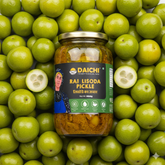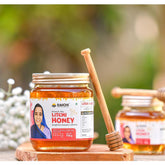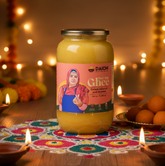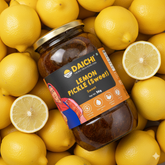The gentle thump of wooden churners, the gradual swirl of curd converting into butter, and that subtle hiss as it melted into golden ghee on a clay burner are sounds that most Indian kitchens used to recognize.
Long before the terms "organic" or "premium" were coined, our grandmothers prepared desi ghee using the Bilona method. The same craft is quietly making a resurgence now.
Because we lost sight of the true flavor of authentic ghee somewhere between "quick" and "convenient."
Ghee is traditionally made in India using the Bilona process, which is methodical, unhurried, and respectful of food.
This is how it takes place:
Curd is made by boiling fresh cow milk, preferably from native breeds that yield A2 milk. After that, the curd is manually churned to separate the butter from the buttermilk using a wooden bilona, a traditional churner. After that, the butter is slowly cooked over a low fire until it turns into golden, grainy, warm, and fragrant Bilona ghee. Only milk, tradition, and time.
Regular ghee is transformed into something sacred—food with soul—through this technique.
Today, most commercial ghee is manufactured from cream rather than curd. In big factories, milk is mechanically separated, cream is removed, and then cooked at high temperatures to generate ghee fast and cheaply.
Yes, it resembles ghee. It smells like ghee. But it isn't the same.
In the Bilona process, the transformation begins with curd, which goes through natural fermentation. That slight variation affects everything: texture, taste, nutrients, and even how your body digests food.
| Feature | Bilona Ghee | Regular Ghee |
| Base | Made from curd (cultured) | Made from cream (uncultured) |
| Process | Hand-churned, slow-cooked | Machine-processed, high heat |
| Aroma | Nutty, warm, aromatic | Flat or overly refined |
| Texture | Grainy, thick | Smooth, sometimes greasy |
| Nutrition | Rich in Omega-3s, butyric acid, vitamins | Often nutrient-depleted |
| Digestion | Easy on stomach | Can feel heavy |
It is naturally high in:
Butyric acid promotes gut health.
Vitamins A, D, E, and K promote skin health, immunity, and bone strength.
Omega-3 and Omega-9 fatty acids support heart and brain function.
And because it's created slowly, the lipids' molecular structure remains intact, allowing your body to absorb and use the nourishment rather than simply storing it. This is why ancient Ayurvedic scriptures refer to ghee as "food for the cells."
Not all milk is created equal.
Desi cow breeds — like Gir, Sahiwal, or Tharparkar — produce A2 milk, which is naturally easier to digest and closer in composition to human milk.
When Bilona ghee is made from this milk, it becomes what Ayurveda calls “Satvik” — pure, healing, and life-giving.
So when you see “Best cow ghee” or “A2 Bilona ghee” on a label, it’s not a marketing term — it’s a mark of authenticity.
It means your ghee has been made from Indian cows, using an Indian method, in the way it was always meant to be.
Taste it once, and you’ll know.
Bilona ghee isn’t just rich — it’s warm, nutty, slightly caramelized.
It doesn’t sit heavy in your stomach; it feels light.
A spoon on your roti makes it softer.
A drop on your khichdi makes it complete.
And somehow, even the smell makes a meal feel like home again.
That’s the difference between manufactured food and made food.
Our grandmothers did not call it A2 Bilona Ghee. They simply called it ghee. Because that was the only sort they knew—the kind that required time, patience, and love. And perhaps that is why we are returning to it now. Because health is more than simply calories and macros; it is about eating foods that remind us of who we are. Opening a jar of Bilona ghee not only benefits your skin and heart, but also connects you to your heritage.
It's a legacy.
Switching to Bilona ghee isn't about following a trend; it's about believing in a heritage. It is rich, pure, light on your body and deeply nourishing.
So if you’re on the lookout for the best cow ghee in India, start by asking one simple question: was it made by hand or by a machine?
Because that answer is often the truest distinction between ordinary and authentic Bilona Ghee.









